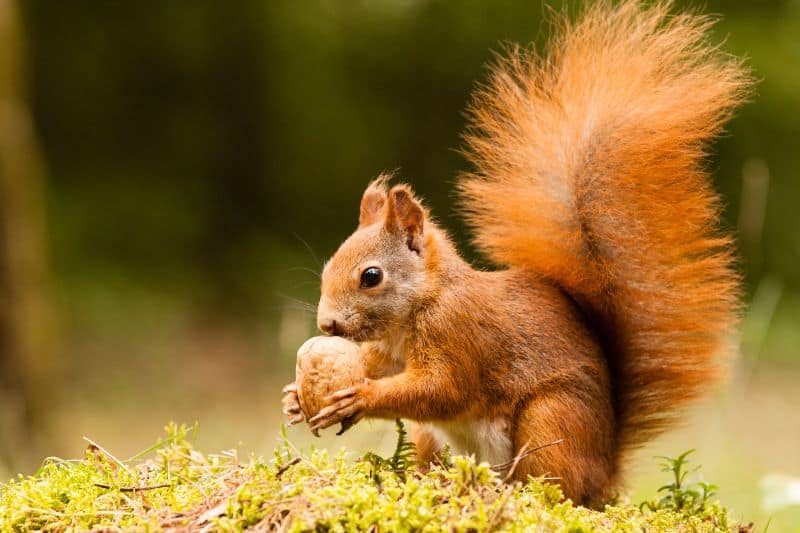Squirrels are fascinating creatures that can often scamper through our yards and parks. Their agility and acrobatics are captivating, but have you ever wondered how much squirrels actually weigh? Understanding their weight can provide insight into their anatomy and habits and how it relate to their environment.
Just like humans, squirrels come in various shapes and sizes. The weight of a squirrel can vary depending on their species, age, and habitat. In this article, we’ll delve into the world of these charming critters and explore the different factors that contribute to their weight.
Read: How Much Does a Shipping Container Weigh? (Tare & Gross Weight)
Grey squirrels are medium-sized squirrels weighing between 14 and 21 ounces. Red squirrels, also native to North America, weigh between 7 and 14 ounces (200 to 400 grams). Flying squirrels are nocturnal creatures weighing only 1.5 to 7 ounces (42 to 200 grams).
Types of Squirrels
There is a diverse world of squirrels out there! In this section, you’ll learn about three categories of squirrels: Tree Squirrels, Ground Squirrels, and Flying Squirrels. Each has unique characteristics, habitats, and behavior that make them distinct from one another.
Tree Squirrels
Tree squirrels are the ones you’re probably most familiar with. They are agile climbers and jumpers, spending most of their time in trees. Some common species in this group include Eastern Gray Squirrels, Red Squirrels, and Fox Squirrels.
They have long, bushy tails, which helps them maintain their balance while navigating the treetops.
Tree squirrels primarily feed on seeds, nuts, berries, and buds. They are well known for burying food items, a behavior called caching, to save for later consumption.
One interesting fact about tree squirrels is that they are scatter-hoarders, meaning they store food in many different small caches, which helps them avoid losing all their food to thieves.
Ground Squirrels
As the name suggests, ground squirrels prefer to dwell on the ground instead of in trees. They are more likely found in open areas such as grasslands and prairies. Ground squirrels, like the Eastern Chipmunk and Thirteen-Lined Ground Squirrel, have cheek pouches that allow them to carry food items back to their burrows.
Their diet varies depending on the species and location but generally consists of seeds, nuts, fruits, insects, and occasionally small animals. Ground squirrels dig intricate burrow systems for shelter and hibernate during winter.
Flying Squirrels
Flying squirrels are quite different from their tree-dwelling and ground-dwelling relatives. Though they don’t truly fly, they do glide through the air with the help of a specialized membrane called the patagium, which stretches between their front and back limbs.
This unique adaptation allows them to easily move from tree to tree as they search for food and avoid predators.
Since flying squirrels are primarily nocturnal, they rely on their large eyes to help them see at night. They consume a varied diet that includes nuts, seeds, fruits, insects, and fungi.

Different Types of Squirrels and Their Weights
Grey Squirrels
Grey squirrels are a common sight in North America. They are medium-sized squirrels, weighing between 14 and 21 ounces (400 to 600 grams). Their bushy tails can be almost as long as their bodies, measuring around 9 to 12 inches (23 to 30 cm).
Red Squirrels
Red squirrels, also native to North America, are smaller than their grey counterparts. They have a distinctive reddish coat and weigh between 7 and 14 ounces (200 to 400 grams). They have a body length of around 11 inches (28 cm), including their bushy tail.
Flying Squirrels
Flying squirrels are quite unique due to the skin flaps connecting their arms and legs, enabling them to glide through the air. There are two main species:
- Northern flying squirrels: These nocturnal creatures weigh only 3.5 to 7 ounces (100 to 200 grams) and measure around 9 to 12 inches (23 to 30 cm) in length.
- Southern flying squirrels: Even smaller than the northern species, these squirrels weigh just 1.5 to 2.5 ounces (42 to 70 grams) and measure between 8 and 10 inches (20 to 25 cm) in length.
Ground Squirrels
Ground squirrels are typically found in open areas like grasslands and deserts. Some common species include:
- California ground squirrels: Weighing between 10 and 17 ounces (280 to 480 grams) with a body length of 9 to 11 inches (23 to 28 cm), these squirrels have distinctive black and white markings on their backs.
- Richardson’s ground squirrels: Also known as gophers, these squirrels weigh between 9 and 14 ounces (250 to 400 grams) and measure 11 to 14 inches (28 to 36 cm) in length.
Juvenile Squirrels
As young squirrels grow, their weight significantly varies until adulthood. Here’s a general guideline for juvenile squirrel weights:
| Age | Weight Range |
|---|---|
| Newborn | 0.3-0.88 oz (8-25g) |
| 1 month old | 1.06-1.58 oz (30-45g) |
| 2 months old | 1.58-3.52 oz (45-100g) |
Here are some weights of other squirrel species:
- African Pygmy Squirrel: 18-34 grams
- Prevost’s Squirrel: 500-750 grams
- Indian Giant Squirrel: 1000-2000 grams

Factors Influencing Squirrel Weight
Diet
The diet of a squirrel can greatly affect its weight. Squirrels are omnivores, meaning they eat both plant and animal materials. The common diet includes:
- Nuts and seeds
- Fruits and berries
- Buds and flowers
- Insects and small invertebrates
They require a balanced diet and nutrition to maintain a healthy weight. An improper diet can lead to either weight loss due to malnutrition or weight gain from an excess of unhealthy food sources.
Age & Growth
As squirrels grow and age, their weight changes accordingly. When they are born, they typically weigh around 6 to 10 grams and are blind, hairless, and helpless. As they grow and develop, their weight gradually increases.
By two months, they have a thick fur coat and have achieved around 60 to 80% of their adult weight. Adult squirrels reach their full weight by 8 to 12 months.
Seasonal Changes
The weight of a squirrel can also be affected by seasonal changes, as their food availability and activity levels fluctuate. In warmer months, when food is more abundant, squirrels may gain weight as they store up fat reserves for the winter.
During winter, when food is scarce and they are less active, they may lose some weight due to relying on their stored fat to survive.
Habitat
The habitat in which a squirrel lives plays a significant role in determining its weight. Squirrels living in dense forests with abundant food sources tend to weigh more than those in less resourceful environments.
Additionally, squirrels in urban areas may have access to human food, which can lead to unhealthy weight gain. Providing a suitable and natural environment for squirrels ensures that they maintain a healthy weight.
Species
Different squirrel species come in various shapes and sizes, all with unique weight ranges. For instance, a common Eastern Gray Squirrel typically weighs between 400 and 600 grams, while a smaller Red Squirrel can weigh between 200 and 350 grams.
Larger species, like the Fox Squirrel, can weigh anywhere from 500 to 1000 grams. Understanding the typical weight range for your squirrel’s species will help you determine if it’s at a healthy weight.
Comparison to Other Animals
You might wonder how a squirrel’s weight compares to animals you commonly see in your backyard or the park. Let’s take a look at some of the differences.
Squirrels typically weigh between 0.77 and 1.1 pounds (350-500 grams), with the average weight being around 0.88 pounds (400 grams). Birds, such as the common pigeons, usually weigh less, with an average weight of about 0.66 pounds (300 grams).
Your furry friend, the domestic cat, tends to be around 5.5 to 16 pounds (2.5-7.2 kilograms) in weight, which is much heavier than squirrels. For our canine companions, the range is even wider.
Smaller breeds, like Chihuahuas, can weigh less than 6 pounds (2.7 kilograms), while larger breeds, like the Labrador Retriever, can weigh anywhere from 55 to 80 pounds (25-36 kilograms).
Regarding rodents, a mouse is much lighter than a squirrel, weighing only 0.035 to 0.088 pounds (16-40 grams). Surprisingly, or perhaps not, the heaviest rodent is the capybara, which can weigh a whopping 77 to 146 pounds (35-66 kilograms)!
Here’s a quick summary in a table format:
| Animal | Average Weight |
|---|---|
| Squirrel | 0.88 pounds (400 grams) |
| Pigeon | 0.66 pounds (300 grams) |
| Domestic Cat | 5.5 to 16 pounds (2.5-7.2 kg) |
| Chihuahua | <6 pounds (2.7 kg) |
| Labrador Retriever | 55 to 80 pounds (25-36 kg) |
| Mouse | 0.035 to 0.088 pounds (16-40 grams) |
| Capybara | 77 to 146 pounds (35-66 kg) |
So, as you can see, squirrels fall on the lighter end of the spectrum compared to some other common animals. Their lightweight bodies are well-suited for their acrobatic tree-climbing and the agility needed for foraging and evading predators.
Conclusion
In your exploration of squirrel weights, you’ve discovered that they can vary considerably. While a general categorization exists between species, gender, age, diet, and habitat contribute to weight diversity.
For example, you’ve seen that a Grey Squirrel typically weighs between 400 and 600 grams. Contrarily, Red Squirrels display a lighter weight range, measuring approximately 250 to 340 grams. Notably, Flying Squirrels are smaller, weighing a mere 90 to 150 grams.







